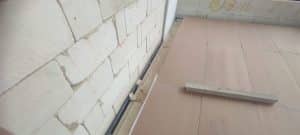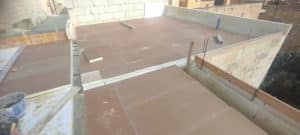If you’re considering microcement for your home, business, or renovation project in Malta, one question probably stands out: is microcement slippery? It’s a critical concern—especially in spaces like bathrooms, kitchens, poolsides, or commercial floors where safety is a top priority. In this guide, we’ll unpack everything you need to know about microcement and its slip resistance.
Here’s the short answer upfront: no, microcement is not slippery when applied and sealed correctly. But let’s take a deep dive to understand why.
1. What Is Microcement?| Is Microcement Slippery
Before discussing slip resistance, it’s helpful to understand what microcement is.
Microcement is a decorative cement-based coating applied in thin layers—usually about 2–3 mm thick. It’s composed of cement, water-based resins, additives, and mineral pigments. The finish is seamless, versatile, and compatible with a wide range of surfaces, including:
Concrete
Tiles
Wood
Plaster
Because of its high-end aesthetic and durability, microcement has become a top choice in modern construction and interior design.
Whether you’re renovating a rustic villa in Gozo or outfitting a sleek retail space in Valletta, microcement offers endless design options. But is microcement slippery? Let’s examine the science.
2. The Science Behind Microcement’s Slip Resistance| Is Microcement Slippery
To address the big question—is microcement slippery?—we need to look at what makes a surface slippery in the first place.
Slipperiness is influenced by:
Surface texture
Moisture
Sealant used
Type of footwear or bare feet
Microcement can be customized during application to have varied finishes—from ultra-smooth to textured. For wet areas like bathrooms or pool surrounds, a more textured microcement finish can be applied to improve grip and reduce the risk of slipping.
Moreover, anti-slip sealers are often used in these settings. These add a slightly grainy texture that boosts friction without compromising aesthetics.
So the answer is clear: microcement is not inherently slippery—it all comes down to how it’s installed and finished.
3. Where Is Slip-Resistant Microcement Most Useful?| Is Microcement Slippery
You’ll find microcement in a range of residential and commercial settings across Malta. Its slip-resistant properties make it ideal for:
Bathrooms: Malta’s humid climate means bathrooms are always a concern for slips. Microcement with anti-slip sealers ensures a safe and stylish solution.
Kitchens: Great for busy homes or restaurants. It’s easy to clean, water-resistant, and can be finished to be non-slip.
Staircases: These are high-risk zones for accidents. With the right textured finish, microcement is both safe and stunning.
Outdoor patios and pool decks: Malta’s coastal weather means outdoor floors are often wet. A properly applied microcement surface ensures grip even when wet.
In short, microcement adapts to both your aesthetic and safety needs.
4. Cost of Slip-Resistant Microcement in Malta| Is Microcement Slippery
So how much does it cost to install microcement that’s safe and non-slippery?
In Malta, microcement typically starts at around €65 per square metre, depending on:
Surface condition and prep work
Type of texture required
Size of the area
Number of layers and sealants used
Adding an anti-slip finish may raise the price slightly, but it’s a worthwhile investment for areas where safety is crucial.
And here’s the good news: microcement offers long-term savings because of its durability, low maintenance, and resistance to wear.
Still wondering is microcement slippery? By this point, you can see that with professional installation, it absolutely does not have to be.
5. Microcement vs. Tiles: Which Is Safer?| Is Microcement Slippery
Many homeowners in Malta compare microcement to traditional tiles. So how do they stack up in terms of slip resistance?
| Feature | Microcement | Traditional Tiles |
|---|---|---|
| Seamless Surface | Yes | No (grout lines) |
| Custom Texturing | Yes (during application) | Limited to tile pattern |
| Anti-Slip Coating | Optional and customizable | Sometimes available |
| Maintenance | Easy—no grout lines | Grout can become slippery |
| Moisture Resistance | High with proper sealers | Depends on tile type and grout |
Verdict: When it comes to slip resistance, microcement offers more flexibility and a smoother, safer experience—especially if you opt for anti-slip coatings. It’s also easier to maintain in Malta’s humid coastal environment.
Understanding the Question: Is Microcement Slippery? | Is Microcement Slippery
In Malta’s sunny and often humid climate, the safety of flooring is a serious concern. A common question that arises is: is microcement slippery? The short and reassuring answer is no, it is not. Thanks to its customizable texture and matte finish, microcement offers excellent grip—even when wet.
In this blog post, we’ll explore 7 revealing facts about microcement and its slip resistance. We’ll explain why it’s a trusted surface for both homes and commercial spaces, how it compares to other flooring types, and how you can maximize safety in your own project. Let’s get started.
1. Microcement’s Surface Texture Improves Grip | Is Microcement Slippery
Microcement is a versatile material that can be applied in a variety of finishes, from ultra-smooth to lightly textured. The beauty of microcement lies in its customizable surface—contractors can add anti-slip agents during the sealing process to enhance friction.
Even without added treatments, microcement finished in a matte or satin texture already offers decent grip underfoot. In wet rooms, poolside areas, or entryways, microcement can be made safer by slightly roughening the surface without compromising on style.
Real-World Example:| Is Microcement Slippery
A popular beach bar in Mellieħa recently chose microcement for its bathroom and bar floors. Thanks to the anti-slip sealer, the surfaces stay safe even with sand and water on them.
2. Why Microcement Outperforms Other Slippery Surfaces | Is Microcement Slippery
Let’s take a moment to compare:
Tiles – These can become very slippery, especially glazed or polished versions.
Polished concrete – While beautiful, it is often slick when wet.
Vinyl or laminate – Not inherently slip-resistant and can warp or become more dangerous with age.
Microcement, on the other hand, offers superior control during installation. The contractor can fine-tune the texture and finish to suit the room’s use—something that isn’t possible with prefabricated materials.
If you’re in Malta and considering flooring for a bathroom, kitchen, terrace, or commercial space, microcement gives you both beauty and peace of mind.
3. Is Microcement Slippery When Wet? | Is Microcement Slippery
This is the core concern for many homeowners and designers. So let’s address it head-on:
No, microcement is not inherently slippery when wet—especially if the right finish is applied.
Because of Malta’s coastal humidity, it’s crucial to select a microcement finish that includes either:
A matte or satin sealant
A specific anti-slip additive during application
Microcement is also non-porous when properly sealed, meaning water will stay on the surface and not seep in. This makes it easy to wipe dry, further reducing any slipping risk.
If you’re applying it around a pool or bathroom area, always inform your installer that slip resistance is a priority. At Kibitec, we can guide you to the best formula and finish for your specific use case.
4. Microcement in Wet Rooms: Ideal or Not? | Is Microcement Slippery
Yes, absolutely ideal. Microcement is increasingly chosen for wet rooms, bathrooms, and even spa areas in Malta.
Here’s why:
It has no grout lines where water can accumulate or mold can grow.
It’s easy to clean and maintain.
The finish can be optimized for safety.
When considering a bathroom renovation or a wet room redesign, many of our clients ask: is microcement slippery in showers or near bathtubs? With the correct application and sealant, the risk is minimal.
You’ll get a seamless, waterproof surface that feels soft underfoot and provides enough grip, even with bare, wet feet.
5. How Much Does Non-Slip Microcement Cost in Malta? | Is Microcement Slippery
Prices vary based on texture, area, and sealant, but here’s a general guide for Malta:
Basic microcement finishes: €60–€75 per square metre
Textured or anti-slip finishes: €70–€85 per square metre
Keep in mind, anti-slip features may involve additional coats or additives, but they’re worth the cost for safety in wet or high-traffic areas.
It’s best to request a custom quote based on the location and use of the space. If you’re curious about options, feel free to reach out to Kibitec’s experts—we’ll walk you through what works best for you.
6. Construction Standards and Safety in Malta | Is Microcement Slippery
Safety in flooring isn’t just about feel—it’s also about compliance. In construction, certain regulations apply to public spaces, like restaurants or clinics. Using a slip-resistant surface like microcement can help meet those standards.
Kibitec regularly installs microcement in hotels, lobbies, offices, and homes throughout Malta and Gozo. All of our solutions follow European safety and environmental standards.
Whether it’s a villa in Madliena or a café in Valletta, your project deserves the best in both looks and safety.
7. Long-Term Performance: Will It Stay Safe Over Time? | Is Microcement Slippery
Yes, and this is one of microcement’s major advantages. Unlike tile grout (which erodes) or laminate (which bubbles with moisture), sealed microcement retains its finish for years.
We recommend periodic resealing every 3–5 years for high-traffic or wet areas. This ensures:
Continued slip resistance
Water repellency
Long-lasting aesthetics
Regular cleaning with soap and water is enough. If needed, we also offer specialty cleaners designed for microcement.
Final Thoughts: So, Is Microcement Slippery? | Is Microcement Slippery
Let’s wrap it up.
Is microcement slippery? Not if it’s applied correctly.
In fact, it’s one of the safest and most elegant options available for Maltese homes and commercial spaces. With the right sealant and finish, it delivers:
Grip and stability
Modern, seamless style
Easy maintenance
Whether you’re redoing a bathroom, resurfacing a pool deck, or designing a new office floor, microcement combines both safety and sophistication.
Contact Us for Safe, Stylish Microcement Solutions | Is Microcement Slippery
If you want a beautiful, non-slip surface tailored to your needs, get in touch with our team at Kibitec. We’re Malta’s experts in microcement application and design.
Let’s talk about your project and help you find the ideal finish to match your vision and keep your space safe.




